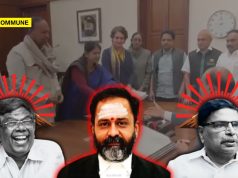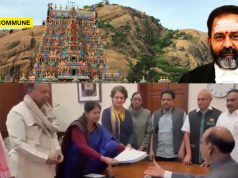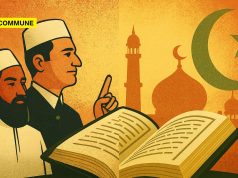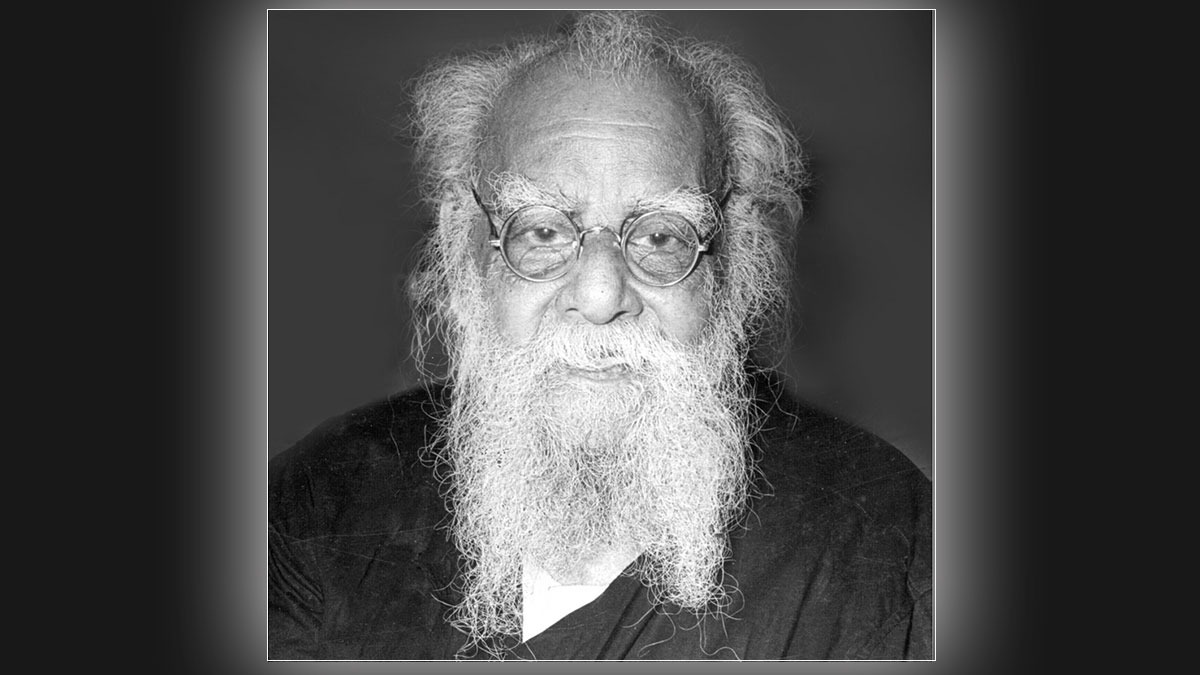
E.V. Ramasamy Naicker, known as “Periyar” by his followers, is seen as a firebrand leader who ushered in a golden era in Tamil Nadu. An image has been constructed of EVR that, if not for him, the people of Tamil Nadu would be living in caves. He is considered as a demigod by Dravidian political parties and outfits. The word “Periyar” is equated with ‘self-respect’, ‘social justice’, ‘rationalism’, ‘woman empowerment’, and a ‘anti-Hindi crusader’ by the Dravidian elements.
The Dravidian chauvinists keep blowing their trumpets about how Periyar still remains a ‘nightmare’ for his opponents. However, of late, the halo created around him has been getting shattered, thanks to internet and social media.
In this age of information, it is hard to conceal the truth and is easy to call out the bluff. Earlier, the truth behind EVR being conferred the title of “Socrates of Southeast Asia” by UNESCO was called out.
In continuation to this, another fact has come to light. In popular rhetoric, EVR is hailed as the person who saved Tamil and Tamil Nadu by standing up to the imposition of Hindi. The Dravidian chauvinists and fanatics claim that Tamil Nadu is “Periyar’s soil” which has no place for Hindi. In fact, Tamil Nadu’s opposition to Hindi today is traced to this man who is said to have protected Tamil and spearheaded the anti-Hindi protests when the then Chief Minister of Madras Presidency C. Rajagopalachari introduced Hindi as a compulsory language in schools in 1938.
However, if truth be told, the first ever Hindi teacher training college was started in EVR’s house at Erode. While the Dakshin Bharat Hindi Prachar Sabha (DBHPS) website notes that it was started in the year 1922, a report by The Hindu says that “In 1927, E.V. Ramasamy Naicker (Periyar) donated his house in Erode for Hindi training college.”
The Hindu report also mentioned that between 1918 and 1928, 1131 students were enrolled for Hindi classes.
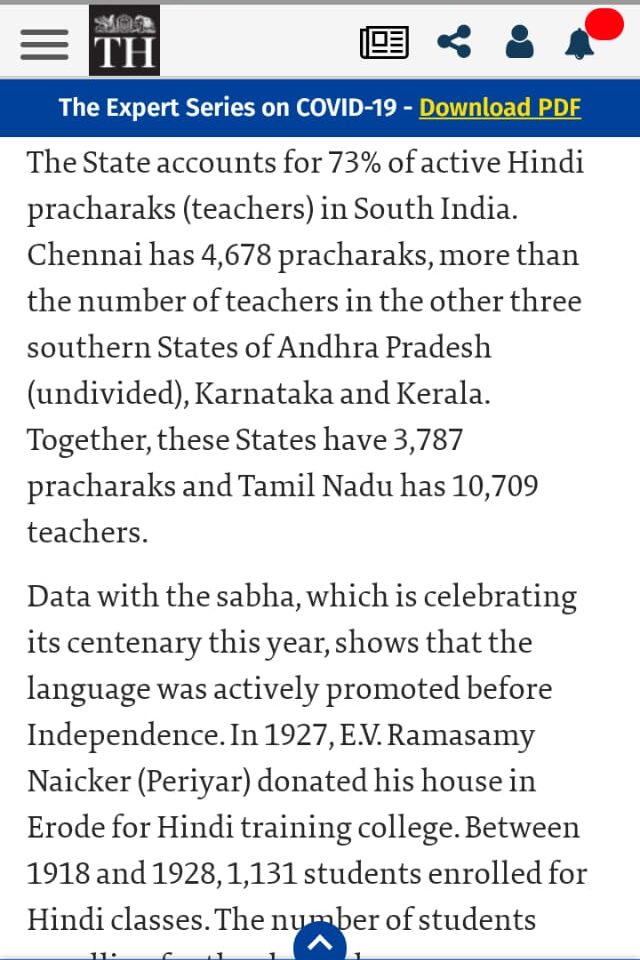
Periyar had given full support to the Dakshin Bharat Hindi Prachar Sabha and it was on behalf of the sabha that Rajaji Vidyalaya High School (CBSE) was started, the DBHPS notes.
Even the anti-Hindi agitations were not started by Periyar. In fact, the seeds of anti-Hindi agitation were first sown by Saivite saints and Tamil scholars like Eezhathu Sivananda Adigal, Arunagiri Adigal, Maraimalai Adigal, Sanmugananda Adigal, K.A.P Viswanathan, Somasundara Bharathiyar, Vimalananda and others. It was these scholars who had first condemned the Rajaji government in 1937 that mandated Hindi to be taught in schools.
Eezhathu Sivananda Adigal in his book “Hindi Edhirpu: Andrum Indrum” (Opposition to Hindi: Then and Now) says that the first protest against Hindi imposition took place in 1937 with 120 members outside the Chief Minister’s residence. On the third day of these protests around 60 people were arrested. At that time, EVR had supposedly told the remaining crowd that these protests are nothing but lazy Congress-style protests that will end up fruitless and asked them not to continue. Eezhathu Adigal goes on to say that EVR had even offered to give money to the protestors to go back to their native places. In response to this, Eezhathu Adigal had respectfully told EVR that his non-interference in the issue would be of great service to Tamil.

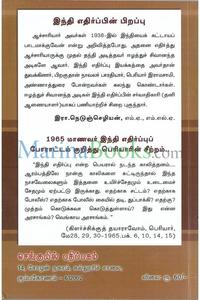
After Eezhathu Sivananda Adigal, Arunagiri Adigal, Sanmugananda Adigal and others were arrested, the protest became leaderless. Upon seeing the reception of the people to these protests, EVR jumped in to take the lead. Just like how he did for Vaikom Satyagraha.
Eezhathu Adigal goes on to say that EVR had later went on to portray himself as the person who laid the foundations of the anti-Hindi protests. But, it does remain a fact that EVR was arrested during these agitations and was released 6 months later.
Later, in a surprise move, he called off the protests in 1939 even before the Rajaji government rolled back the move. When the press had asked about this sudden move, EVR had told:
“The anti-Hindi agitations were used by me only to trouble the Congress government ministers. I do not care if Hindi gets imposed or Tamil gets perished.” (Hindi Edhirpu: Andrum Indrum, Page 30).
To this, Eezhathu Sivananda Adigal had said that EVR does not have any right to call off the protest and gave an announcement on November 4, 1939 that a protest would happen in front of the Governor’s bungalow. It was only on February 21, 1940 that the Rajaji government rolled back its move of imposing Hindi.
When the Official Languages Act of 1963 was passed by the Congress government at the Centre, another round of anti-Hindi agitations broke out. This time the DMK jumped into the student led protests. To this, EVR out of the jealousy over Anna’s rise as a leader, had written an essay in his Viduthalai magazine saying that a regime without suppression is only an anarchy, indirectly calling for Anna to quell the protest. Even though the DMK had extended its support for the anti-Hindi agitations, it had given an order to the students on February 10, 1965 to call of the protests. He had even said that these agitations no longer have any connections with the DMK.
In the issue of Viduthalai dated March 3, 1965, Periyar in his editorial piece answered to the questions posed to him about his ambiguous stance on anti-Hindi agitations. He said that he still opposed Hindi not because out of concern that Tamil might get spoilt but to promote English. “What is there in Tamil to get spoilt?”, he had said. He noted that Hindi opposition was a political problem and not a linguistic issue.
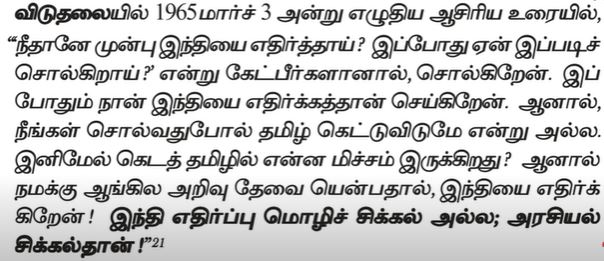
In an interview to Ananda Vikatan on April 11, 1965, EVR was asked by the reporter/interviewer Savi about the Central government asking its employees to learn Hindi upon joining service to which EVR replied “Just learn and go. What is the problem? Don’t those who work at Tahsildar’s office learn about surveying land? Why can’t you study Hindi similarly?”
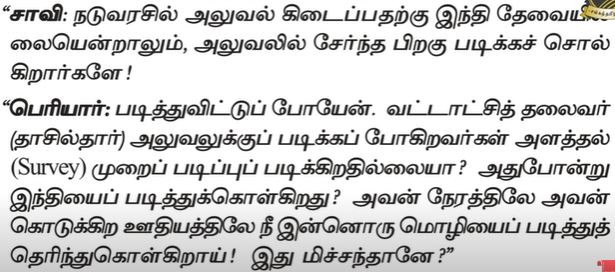
“He (Central government) is even giving you salary to learn a new language. Isn’t it a good deal?”, EVR had said.
So, it is clear from all this that Periyar’s anti-Hindi agitations was nothing but another sham in the list of shams to his name.

